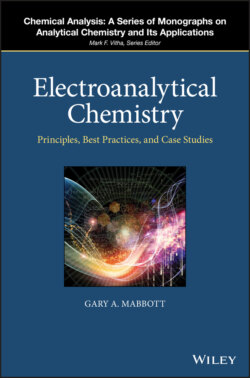Читать книгу Electroanalytical Chemistry - Gary A. Mabbott - Страница 28
Problems
Оглавление1 1.1 A bourbon distillery treats its discharge water (that remains behind after the whisky distills off) electrochemically to remove copper by plating it out on an electrode. After 42 days of continuous operation the electrode was replaced. It was weighed before sending it off to a copper recycling service and was found to have recovered 450 g of copper. Calculate the average current during its use assuming that 100% of the current was used in the reduction of Cu2+ to Cu metal.
2 1.2 Consider a carbon electrode with a circular shape and a diameter of 3.0 mm dipping into a 0.1 M NaCl solution with a double layer capacitance of 20 μF/cm2. If the electrode receives a pulse of 1.0 × 1012 electrons, what will the change in voltage be at the electrode solution interface.
3 1.3 The diffusion coefficient for NO3− ion is bigger than the diffusion coefficient for Na+ ion. Consider measuring the electrochemical cell potential in which a salt bridge is used between the reference solution containing 3 M NaNO3 and a sample containing 0.1 M NaNO3 supporting electrolyte solution. Explain whether there will be a junction potential and, if so, whether the cell potential with the junction potential will appear more positive or more negative than without it.
4 1.4 Explain why ohmic loss is more likely to cause a serious error in a voltammetry experiment than it is for a potentiometric experiment.
5 1.5 If 250 μA of current flows when a potentiostat applies −0.351 V to an electrochemical cell with a resistance of 152 Ω, what is the ohmic loss in voltage?
6 1.6 Explain two different mechanisms that could cause the potential of a pH electrode to shift upon the addition of 3 g of KCl to 100 ml of a solution of 0.1 M HCl.
7 1.7 How many moles of electrons would be required to change the voltage on a Pt circular disk electrode with a 2.0 mm diameter from −0.100 to −0.500 V in an electrolyte solution of 0.1 M KCl given the electrode solution capacitance of 24 μF/cm2?
8 1.8 The average thermal energy (or the average kinetic energy) in three dimensions for a molecule is often give as 3/2 kT where k is Boltzmann's constant and T is the absolute temperature. How does the average thermal energy of a molecule at 25 °C compare with 1 eV?
9 1.9 How does the energy of a blue photon at 400 nm compare to 1 eV?
10 1.10 How does the dissociation energy of the carbon–carbon bond in an ethane molecule compare with 1 eV?
